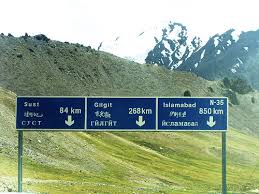Dr Abdul Jalil
Back in 1979, Gilgit-Baltistan (GB) saw the commissioning of Karakoram Highway (KKH) linking the area with the rest of the country. Being an extremely difficult, inaccessible and seismically active terrain, it was almost a herculean task to reach GB about forty years ago. The mighty mountains of Karakoram, Hindu Kush and Himalayas meeting at a point about forty kilometres to the west of Gilgit city always posed a great challenge to the climbers and road builders.
It was simply beyond imagination of the people of GB that they shall ever be linked with their own country and the world around by a road wide enough to accommodate a loaded truck bringing in goods and other essential commodities to this remote, isolated mountainous landlocked area.
If somebody had a chance to visit GB about forty years ago and happens to revisit now, he will probably not believe his own eyes and shall be amazed to see the tremendous tangible development that has occurred in all spheres of life during the last four decades.
During the late President Ayub Khan’s era in 1960, a team of Pakistan Army engineers carried out the initial survey and made lay out of the road along the banks of River Indus. While preparing the feasibility report the American experts were also consulted. It is reported that one American expert was so disappointed on seeing the mountains and narrow valleys that he was heard as saying, ‘We just cannot see a road pushed through these terrible mountains and if we manage to build one, we shall probably spend the rest of our lives to keep it open’.
In the backdrop of such awful and disappointing circumstances, the construction of KKH was entrusted to a Pakistani road building company popularly known as FWO.
Such an arduous journey of mountain breaking, huge rocks moving and carving out of a road was never undertaken by any road building company in the past and in the contemporary history which took twenty three long years to accomplish this gigantic task of KKH building, about 806 KMs long extending from Hasan Abdal in Punjab to Khunjerab Pass in Hunza.
In the ensuing years of KKH commissioning, an agreement between China and Pakistan was inked pertaining to widening and partial modification of the existing alignment. Subsequent to this agreement, thousands of Chinese engineers and workers crossed into GB and completed the assigned task in a few years. KKH made vast swathes of inaccessible terrains accessible spreading from Batgram to Khunjerab Pass on the Pak-China border. Undoubtedly, KKH has ushered in an economic, cultural and educational revolution amongst the people of GB by breaking the centuries old shackles of poverty, ignorance, isolation and economic backwardress in GB.
China-Pakistan Economic Corridor (CPEC) has today caught the attention of Pakistani masses and is in the limelight of print and electronic media. Skyrocketing hopes are attached with CPEC and political pundits are predicting a rainfall of riches as soon as the construction of CPEC is over, which of course is mind boggling. Print and electronic media are blowing the CPEC out of proportion and inadvertently alerting the adversaries of Pak-China friendship who are brooding to sabotage the entire process.
During the past decade, a mushroom growth of politicians has occurred in GB who in order to popularise themselves are hurling virulent statements on CPEC to make it a controversial issue for their vested interests. In fact, there is hardly anything which is in conflict. The reservations expressed by the critics are not clearly enunciated. CPEC is the modern version of KKH and as such there is nothing new in it as far as GB is concerned. CPEC is aimed at widening and straightening of the existing KKH. Location and alignment of CPEC is not being changed on account of the narrowness of valleys in GB.
No economic zone can be set up along this road from Hunza to Juglote, Gilgit, as there is no land or infrastructure available along this stretch of the road. However, there exists a piece of arid land 40 KMs long and three KMs wide opposite Juglote across River Indus in Bunji, Astore. If deemed fit, this piece of land can be utilised for the said purpose.
CPEC, it is assumed, shall open new avenues of prosperity for all the four provinces, and GB. Instead of engaging the incumbent government in petty controversial matters, we should rather support and appreciate its efforts so that the dream of CPEC becomes a reality.
The bulk of population in GB who lived below poverty line about three to four decades ago have now risen high from the abyss of poverty to the pinnacle of affluence in a short span of time. Hopefully, CPEC shall keep spewing its bounties on the people of GB like its predecessor KKH.

